Review Primary Arms 4-14x44mm Riflescope - Acss Hud Dmr
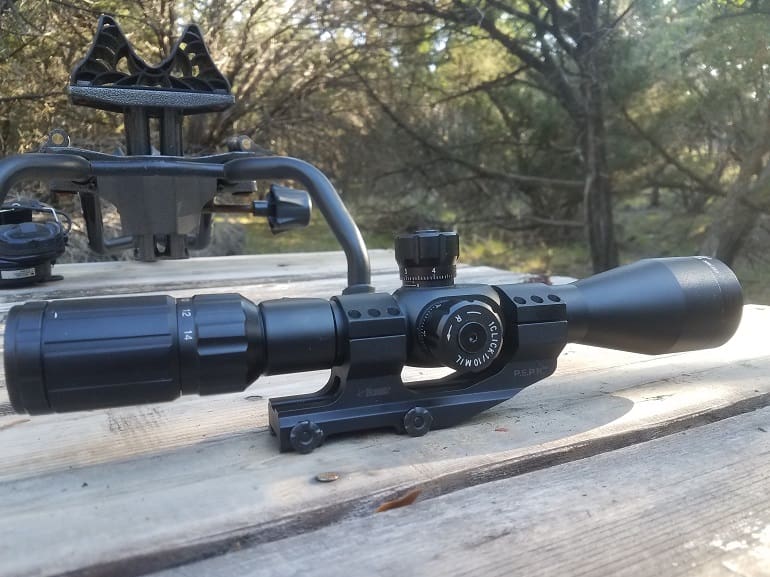
It'south pretty impressive how far budget eyes take come. For the kickoff in a serial of budget optic reviews, I put the Primary Arms four-14X40 ACSS DMR/HUD riflescope through its paces. The Chinese-made manufacturer has a cult following of loyal customers and every bit this scope proved, at that place are a lot of skilful reasons for that.
Let'south go the not-so-great role out of the way get-go. The optic's clarity is mediocre. Information technology's non horrible, but it's non astonishing either.
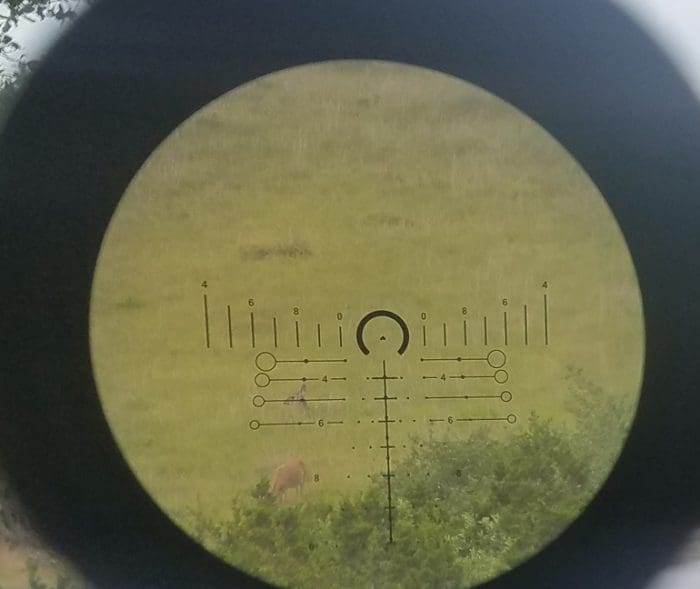
The photo higher up shows some White Tail does bedded down at 400 yards correct at dusk, with the scope on full 14X magnification. That image quality is OK, and it's certainly practiced enough to make the shot, but but for some other 100 to 200 yards or and so, not the entire magnification range. At long range, then the prototype becomes too fuzzy to take an ethical shot.
At present, if your target isn't a living thing, something static, the target volition probably seem clearer. But used on game or anything moving, it'due south too hard to go enough focus at long distances. That said, you lot have to ask yourself how often you're really going to demand to take a shot at game that's more than than 600 yards away.
What'south and so impressive virtually the Chief Artillery eyes is the number of features a marksman gets for his coin.
This is a front focal plane scope, significant the paradigm is on the beginning airplane, not the second. The issue is that the ffp scope reticle changes size in correlation with the magnification of the telescopic, allowing the user to guess range and employ the built-in holdovers at whatsoever magnification. On traditional second focal plane scopes, ranging is usually done only at the highest magnification.
A drawback to starting time focal plane scopes is that they're unremarkably more than expensive, although not in this example. They also usually don't have quite the precise level clarity on the reticle as second focal aeroplane scopes practise. On this telescopic, reticle clarity wasn't an upshot at all, equally the overall clarity of the glass just wasn't infrequent to brainstorm with.
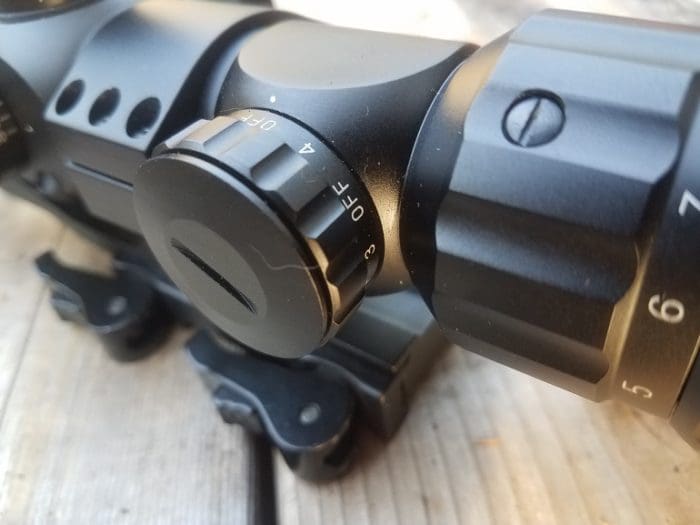
The illuminated ACSS-HUD-DMR reticle pops out well confronting a black target, and has off positions between each brightness level. I've seen that feature on more expensive optics, and information technology'due south much appreciated. It is, however, likewise bright on whatsoever setting for employ with IR dark vision devices, as information technology simply floods the entire image.
On this model, both the windage and pinnacle knobs are in mils, with .10 mil aligning clicks. It's like shooting fish in a barrel to move the brightly marked knobs, and they have very tactile and audible clicks to them to count a mil.
The parallax adjustment (and no, that'southward not a focus knob) is easily finger adjustable and is capable of fine adjustments.

The magnification aligning was done particularly well. It'south a single, large, knurled exposed turret that moves easy plenty that I don't accept to change position at all to adjust it with one paw, nonetheless stays in identify one time it's set. I've seen a lot more expensive optics with much rougher movement. I constitute no distortion or lack of focus even at the highest magnification levels.
Exist careful what mount you employ on this scope. When I showtime tested the reliability of this scope, I had it mounted on a lightweight AR chambered in .458 SOCOM. It wouldn't hold a precise null betwixt shots. Earlier I had to requite the telescopic cypher stars, I checked the mount to make certain that wasn't the problem. In society to get proper centre relief without spanning the receiver and the hand baby-sit rail, I needed a cantilever mount, and I had used one made by Atibal. I switched that one out and tried ane made by Warne, as well as 1 from by Burris.
On the Warne and and then Burris scope mounts, on several unlike guns, the problem disappeared. With those stronger mounts, the PA 4-14X44 held zero perfectly.
Some cantilever mounts can act like diving boards under recoil. If yous're using a heavier scope, (and this one is barely on the heavy side) the telescopic weight causes the mount to dip under recoil. That cantilever and so springs back, violently shaking the mount and the glass in the optic. It likely won't have that upshot on a lighter-recoiling burglarize, similar a standard AR-15 shooting 5.56 NATO. The effect besides doesn't exist with traditional mounts without the cantilever.
This event was verified by Bill Wilson of Wilson Combat. Wilson Combat used a slow-motion camera for product development. Neb told me that, with the slo-mo camera, he could lookout man cantilever mounts dip way down and so spring support under recoil. The scopes within the rings took a chirapsia. The higher the recoil of the rifle, or the heavier the scope, the more of a beating the optic took.
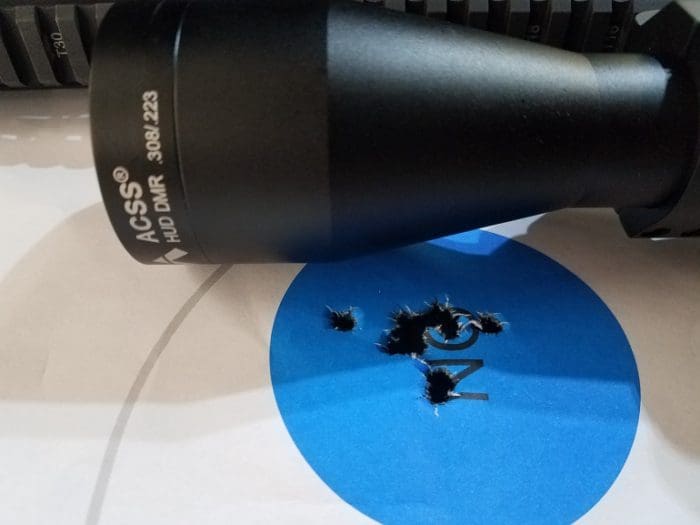
In one case I had the scope mounted in a more robust mount, I had no issues with information technology property zero with any platform. To prove it was stone solid, I sat downwardly with a Colt Competition AR-xv in a Caldwell Stinger shooting rest, all bagged up and stable. I put 1 full magazine through the burglarize in ane infinitesimal's fourth dimension, aiming at the exact aforementioned spot. All thirty rounds were within a 1.two inches of each other.
No telescopic test would be complete without at to the lowest degree some semblance of a box test. I ran a very unproblematic test at 100 yards. As the scope's turrets are in Mil/Mil, I ran the exam in centimeters. I shot a group, dialed what should have been 12cm left, shot a group, upwardly 12cm, shot a group, correct 12cm, shot a group, and back downward 12cm. The last series of shots ended upwardly right on top of the first serial. Box checked.
I likewise simply shot a circular, counted all the clicks to the correct, so brought it dorsum that number of clicks, shot, brought it left all the way and counted the clicks, brought it back, and shot. I ended up with three rounds within an inch.
All of this shooting was done with the scope mounted on top of a Colt Competition AR15 that has proven to shoot under 1MOA. All shooting was done in a Caldwell Stinger Shooting rest on a sturdy bench.
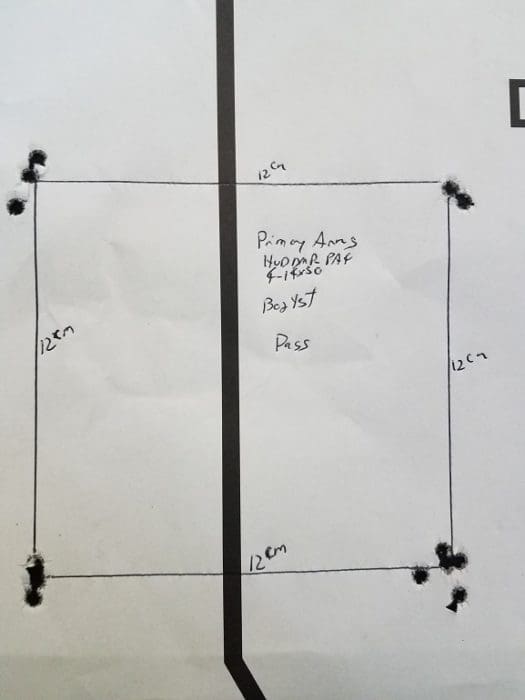
In brusque, the turrets track accurately throughout their entire length of travel.
This scope is equipped with the Main Arms ACSS HUD DMR reticle. The point of the ACSS HUD DMR reticle is that you lot tin can use it to estimate both range and windage holds. The Primary Arms website proclaims "No math needed, no digging through the data book!"
No. Not just no, hell no. Perchance even Helz Naw! Never requite upward your information book.
Ballistic reticles like the ACSS — and this is a proficient i — provide the user with built-in holdovers for pinnacle and windage. Simply with a pretty massive caveat. They are expert for a specific bullet, at a specific speed, nether specific environmental conditions.
This PA ACSS HUD DMR will piece of work for a few dissimilar rounds, all detailed in the manual. For case, the .308 reticle volition work for .308 loads that are 175gr SMK at 2550 to 2600 fps with a fifty-yard cipher, or a 168gr SMK at 2,700fps with a 100 yard zero or two,600 fps with a 200 yard cypher. The ACSS reticle also lines upwardly with a few .223/5.56 NATO ammo loads as well every bit 1 6.five Grendel load.
Not shooting one of those loads? Then the patented ACSS reticle's features won't really work for yous.
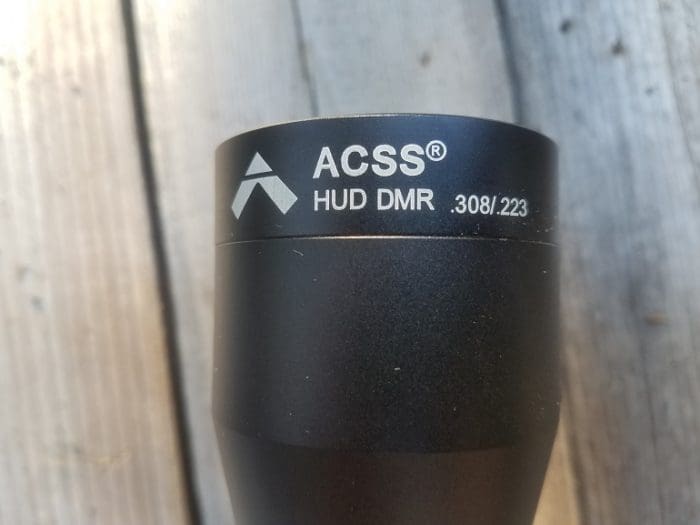
I was able to verify that, out to 600 yards, several of the listed loads practise in fact line up. They may piece of work fifty-fifty farther, but by 600 yards I was having trouble with the wind on a 1.2-MOA target.
But expect, aren't there current of air holds also? Yes, and they're good for 5mph and 10mph wind. But I plant this to be of petty value with the target size I was shooting. For case, at 600 yards, the recommended 77 grain Hornady A-Max round moving at 2800 fps (20″ barrel) hits at .nine mil or xix.viii inches of windage. What if the air current is just 3mph more? In that location is no 8 mph cross-hair concord, and at 8 mph it'southward one.5 mils of wind, or 31.8 inches off the center of the target. It'south about the same for the .308 168-grain SMK round at 2700 fps.
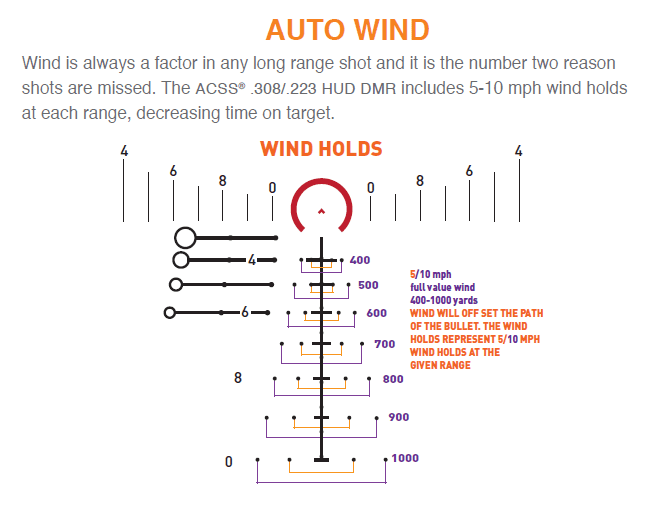
That may seem like a lot, and for many game animals that really is too much of a discrepancy to only employ the wind holds to reliably shoot. Afterward all, that's a 12-inch deviation at 600 yards, larger than the breadbasket of mutual game animals. But it does fit right within a man silhouette, and it works for middle/lung sized targets if yous're at the beginning wind concur, the 400 yard mark. Information technology also works by the 600 thousand marker, as long as you're considering an surface area target, not a human sized or smaller target.
Of grade, if y'all get lucky, and the wind is either 5mph or 10mph, using the listed rounds, nether the right conditions, it works just perfectly.
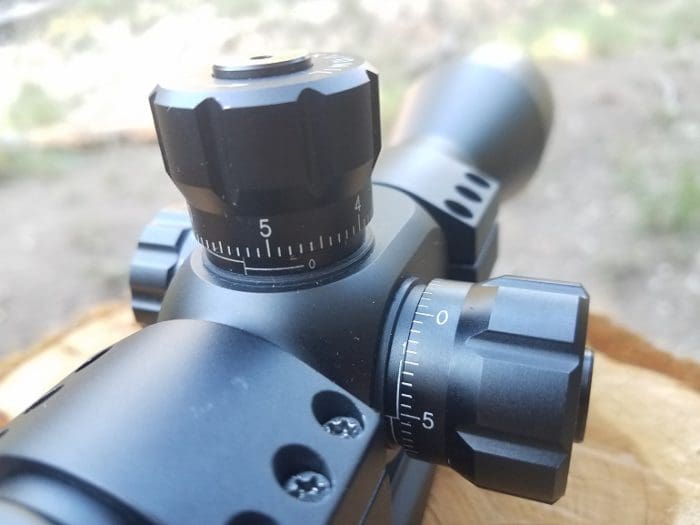
Overall, I wouldn't use this ffp riflescope reticle. There is a lot of data in the view through the telescopic, and it'due south too much for me to think about. I'd rather go back to lasing the target and dialing my bullet drop corrections based on Data on Prior Engagements/Directly Observation of Prior Engagements (DOPE). Or based on my own trued ballistic software.
It was much faster for me to just use the scope in the traditional manner, dialing corrections. If I used this scope with a dedicated round and shot information technology all the time, that would exist different.
Overall, Chief Arms is giving you a lot of features for the money. No, the drinking glass doesn't come shut to Schmidt & Bender, US Eyes, or even the Vortex Viper PST line. But the PA 4-14 ACSS HUD/DMR costs a small fraction of those scopes with an MSRP of but $279.99.
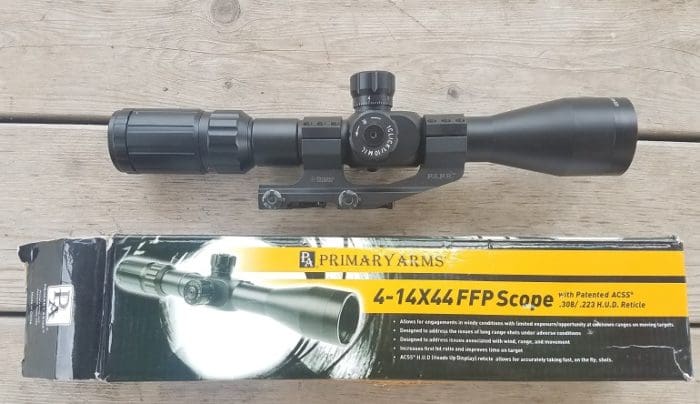
Specifications: Primary Artillery 4-14X44 ACSS HUD/DMR Riflescope
Battery Type: CR2032 3V Lithium Coin
Turret Manner: Turrets
Click Value: 0.i Mil
Exit Pupil Diameter: Low: xi.xx mm/Loftier: 3.30 mm
Eye Relief: Depression: 3.22 in/High: 3.14 in
Field of View 100: Depression: 27.20 ft/High: 7.85 ft
Focal Plane: First Focal Airplane
Illuminated Reticle, multiple brightness settings, center chevron
Length: 12.9 in
End: Matte blackness
Maximum Magnification: 14
Minimum Magnification: 4
Nighttime Vision Uniform: Non-Compatible
Objective Bore: 44mm
Reticle: ACSS HUD DMR 5.56 NATO
Reticle Blazon: BDC
Total Tiptop Adjustment: xxx Mils
Total Windage Adjustment: thirty Mils
Tube Diameter: 30mm
Extras: Waterproof, shockproof, and fog resistant
MSRP: $279.99
Ratings (out of five stars):
Drinking glass quality and clarity * *
Great glass still costs practiced money, and this is one feature — probably the only feature — that Master Artillery couldn't clasp into this telescopic at this price bespeak. Leupold and Vortex Optics shooters will be disappointed.
Reliability * * * *
With a sturdy mount, that reticle won't budge. Just make sure you accept a strong mount if you're going to utilise a cantilever mount on a stout-recoiling burglarize.
Knob and Turret Quality * * * *
Good tactile and aural feedback with sure and piece of cake motility.
Overall * * *
Glass clarity isn't anything special, only everything else is very good. Main Artillery continues to show that budget optics tin can offer you a lot of functioning for your money, and y'all might want it on your wish list.
jonesmarobluns1980.blogspot.com
Source: https://www.thetruthaboutguns.com/optic-review-primary-arms-4-14x44-acss-dmrhud-riflescope/
0 Response to "Review Primary Arms 4-14x44mm Riflescope - Acss Hud Dmr"
Post a Comment